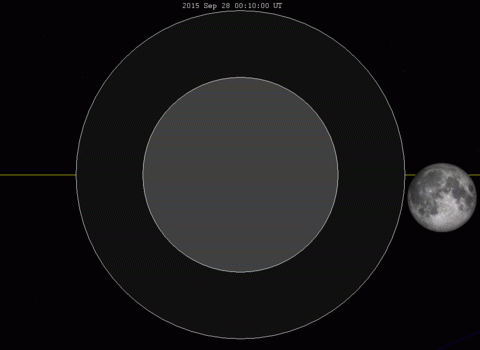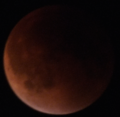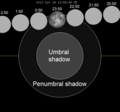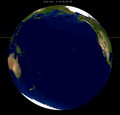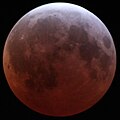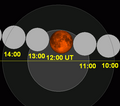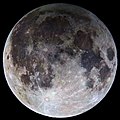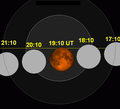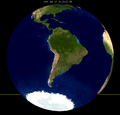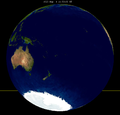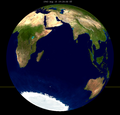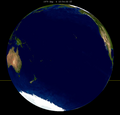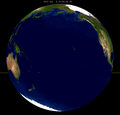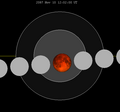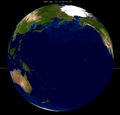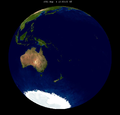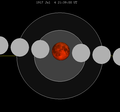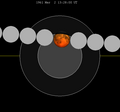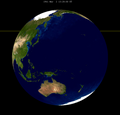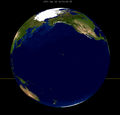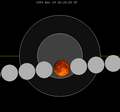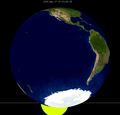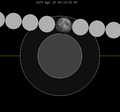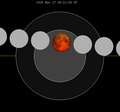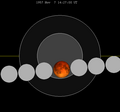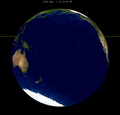Top Qs
Timeline
Chat
Perspective
September 2015 lunar eclipse
Total lunar eclipse of 27 September 2015 From Wikipedia, the free encyclopedia
Remove ads
A total lunar eclipse occurred at the Moon’s descending node of orbit on Monday, September 28, 2015,[1] with an umbral magnitude of 1.2774. A lunar eclipse occurs when the Moon moves into the Earth's shadow, causing the Moon to be darkened. A total lunar eclipse occurs when the Moon's near side entirely passes into the Earth's umbral shadow. Unlike a solar eclipse, which can only be viewed from a relatively small area of the world, a lunar eclipse may be viewed from anywhere on the night side of Earth. A total lunar eclipse can last up to nearly two hours, while a total solar eclipse lasts only a few minutes at any given place, because the Moon's shadow is smaller. Occurring only about 5 hours after perigee (on September 27, 2015, at 21:45 UTC), the Moon's apparent diameter was larger.[2]
This lunar eclipse is the last of a tetrad, with four total lunar eclipses in series, the others being on April 15, 2014; October 8, 2014; and April 4, 2015.
The Moon appeared larger than normal, because the Moon was just 1 hour past its closest approach to Earth in 2015 at mid-eclipse, sometimes called a supermoon. The Moon's apparent diameter was larger than 34' viewed straight overhead, just off the coast of northeast Brazil.[3][4]
The total lunar eclipse was darker than expected, possibly due to ash left behind from eruptions of the Calbuco volcano in April 2015.[5]
Remove ads
Background
A lunar eclipse occurs when the Moon passes within Earth's umbra (shadow). As the eclipse begins, Earth's shadow first darkens the Moon slightly. Then, the shadow begins to "cover" part of the Moon, turning it a dark red-brown color (typically – the color can vary based on atmospheric conditions). The Moon appears to be reddish because of Rayleigh scattering (the same effect that causes sunsets to appear reddish) and the refraction of that light by Earth's atmosphere into its umbra.[6]
The following simulation shows the approximate appearance of the Moon passing through Earth's shadow. The Moon's brightness is exaggerated within the umbral shadow. The northern portion of the Moon was closest to the center of the shadow, making it darkest, and most red in appearance.
Remove ads
Supermoon
This eclipsed Moon appeared 12.9% larger in diameter than the April 2015 lunar eclipse, measured as 29.66' and 33.47' in diameter from Earth's center, as compared in these simulated images.
A supermoon is the coincidence of a full moon or a new moon with the closest approach the Moon makes to the Earth on its elliptical orbit, resulting in the largest apparent size of the lunar disk as seen from Earth. This was the last supermoon lunar eclipse until January 31, 2018.

Remove ads
Visibility
The eclipse was completely visible over eastern North America, South America, west Africa, and western Europe, seen rising over western North America and the eastern Pacific Ocean and setting over east Africa, eastern Europe, and west and central Asia.[7]
 |
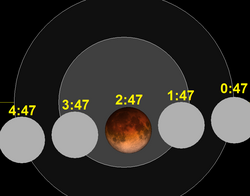 Hourly motion shown right to left |
 Simulated appearance of Earth and atmospheric ring of sunlight |
 The Moon's hourly motion across the Earth's shadow in the constellation of Pisces. |
 Visibility map | |||
Timing
Summarize
Perspective
† The Moon was not visible during this part of the eclipse in this time zone.
* The penumbral phase of the eclipse changes the appearance of the Moon only slightly and is generally not noticeable.[8]

The timing of total lunar eclipses are determined by its contacts:[9]
|
Remove ads
Gallery
- The stages of the Lunar eclipse from Staffordshire, UK
- Time-lapse images from Oslo, Norway
- Time-lapse images from Bregenz, Austria
- Warsaw, Poland, 2:01 - 2:16 UTC
- Denver, Colorado, 2:15 UTC
- Fray Bentos, Uruguay 2:28 UTC
- Tampa, Florida, 2:30 UTC
- New York City, New York, 2:36 UTC
- Wrocław, Poland, 2:36 UTC
- Zürich, Switzerland, 2:36 UTC
- Coralville, Iowa, 2:52 UTC
- Munich, Germany, 2:55 UTC
- Sitia, Greece, 3:01 UTC
- Berlin, Germany, 3:05 UTC
- Mill Valley, California, 3:07 UTC
- Munich, Germany, 3:23 UTC
- Boston, Massachusetts, 3:24 UTC
- Germany, 3:37 UTC
- Cosne-Cours-sur-Loire, France, 4:02 UTC
- California, 4:07 UTC
Remove ads
Eclipse details
Shown below is a table displaying details about this particular lunar eclipse. It describes various parameters pertaining to this eclipse.[10]
Remove ads
Eclipse season
This eclipse is part of an eclipse season, a period, roughly every six months, when eclipses occur. Only two (or occasionally three) eclipse seasons occur each year, and each season lasts about 35 days and repeats just short of six months (173 days) later; thus two full eclipse seasons always occur each year. Either two or three eclipses happen each eclipse season. In the sequence below, each eclipse is separated by a fortnight.
Remove ads
Related eclipses
Summarize
Perspective
Eclipses in 2015
- A total solar eclipse on March 20.
- A total lunar eclipse on April 4.
- A partial solar eclipse on September 13.
- A total lunar eclipse on September 28.
Metonic
- Preceded by: Lunar eclipse of December 10, 2011
- Followed by: Lunar eclipse of July 16, 2019
Tzolkinex
- Preceded by: Lunar eclipse of August 16, 2008
- Followed by: Lunar eclipse of November 8, 2022
Half-Saros
- Preceded by: Solar eclipse of September 22, 2006
- Followed by: Solar eclipse of October 2, 2024
Tritos
- Preceded by: Lunar eclipse of October 28, 2004
- Followed by: Lunar eclipse of August 28, 2026
Lunar Saros 137
- Preceded by: Lunar eclipse of September 16, 1997
- Followed by: Lunar eclipse of October 8, 2033
Inex
- Preceded by: Lunar eclipse of October 17, 1986
- Followed by: Lunar eclipse of September 7, 2044
Triad
- Preceded by: Lunar eclipse of November 27, 1928
- Followed by: Lunar eclipse of July 30, 2102
Lunar eclipses of 2013–2016
This eclipse is a member of a semester series. An eclipse in a semester series of lunar eclipses repeats approximately every 177 days and 4 hours (a semester) at alternating nodes of the Moon's orbit.[11]
The penumbral lunar eclipse on May 25, 2013 occurs in the previous lunar year eclipse set, and the penumbral lunar eclipse on August 18, 2016 occurs in the next lunar year eclipse set.
Saros 137
This eclipse is a part of Saros series 137, repeating every 18 years, 11 days, and containing 78 events. The series started with a penumbral lunar eclipse on December 17, 1564. It contains partial eclipses from June 10, 1835 through August 26, 1961; total eclipses from September 6, 1979 through June 28, 2466; and a second set of partial eclipses from July 9, 2484 through September 12, 2592. The series ends at member 78 as a penumbral eclipse on April 20, 2953.
The longest duration of totality will be produced by member 44 at 99 minutes, 53 seconds on April 13, 2340. All eclipses in this series occur at the Moon’s descending node of orbit.[12]
Eclipses are tabulated in three columns; every third eclipse in the same column is one exeligmos apart, so they all cast shadows over approximately the same parts of the Earth.
Tritos series
This eclipse is a part of a tritos cycle, repeating at alternating nodes every 135 synodic months (≈ 3986.63 days, or 11 years minus 1 month). Their appearance and longitude are irregular due to a lack of synchronization with the anomalistic month (period of perigee), but groupings of 3 tritos cycles (≈ 33 years minus 3 months) come close (≈ 434.044 anomalistic months), so eclipses are similar in these groupings.
Inex series
This eclipse is a part of the long period inex cycle, repeating at alternating nodes, every 358 synodic months (≈ 10,571.95 days, or 29 years minus 20 days). Their appearance and longitude are irregular due to a lack of synchronization with the anomalistic month (period of perigee). However, groupings of 3 inex cycles (≈ 87 years minus 2 months) comes close (≈ 1,151.02 anomalistic months), so eclipses are similar in these groupings.
Half-Saros cycle
A lunar eclipse will be preceded and followed by solar eclipses by 9 years and 5.5 days (a half saros).[14] This lunar eclipse is related to two annular solar eclipses of solar saros 144.
Remove ads
See also
References
External links
Wikiwand - on
Seamless Wikipedia browsing. On steroids.
Remove ads


